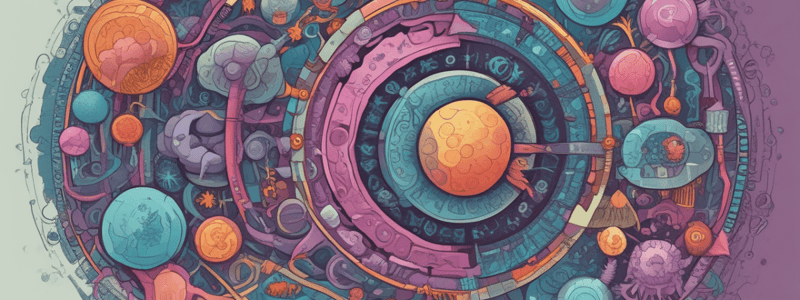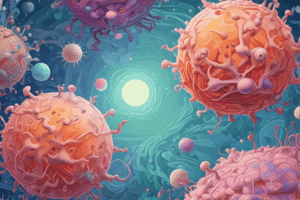Podcast
Questions and Answers
Which step in the Cancer Immunity Cycle involves the release of cancer cell antigens?
Which step in the Cancer Immunity Cycle involves the release of cancer cell antigens?
- Recognition of Cancer Cells
- Trafficking of T cells to Tumours
- Priming and Activation (correct)
- Cancer cell presentation
What could be a reason for a tumor to be classified as a 'Cold tumour'?
What could be a reason for a tumor to be classified as a 'Cold tumour'?
- Lack of T-cell attracting chemokines (correct)
- Major T-cell infiltration
- Defects in antigen presentation
- Immune evasion due to stromal barriers
Why may T cells not properly home to tumors according to the text?
Why may T cells not properly home to tumors according to the text?
- Lack of chemokines in immune-excluded tumors (correct)
- Factors in the tumor microenvironment might suppress the effector cells
- DCs and T cells treat antigens as self
- Tumor antigens may not be detected
What is a characteristic of 'Immune-excluded tumours' based on the information provided?
What is a characteristic of 'Immune-excluded tumours' based on the information provided?
Which step in the Cancer Immunity Cycle involves the trafficking of T cells to tumors?
Which step in the Cancer Immunity Cycle involves the trafficking of T cells to tumors?
What could be a factor contributing to the immuno-suppression of effector cells in the tumor microenvironment?
What could be a factor contributing to the immuno-suppression of effector cells in the tumor microenvironment?
What is a common characteristic of 'Cold tumours' based on the context provided?
What is a common characteristic of 'Cold tumours' based on the context provided?
What could contribute to a tumor being categorized as 'Immune-excluded'?
What could contribute to a tumor being categorized as 'Immune-excluded'?
Why might DCs and T cells treat antigens as 'self' in cancer patients?
Why might DCs and T cells treat antigens as 'self' in cancer patients?
What is the principal source of the extracellular matrix?
What is the principal source of the extracellular matrix?
Which cells are associated with enhanced proliferative, migratory, and secretory properties in the tumor microenvironment?
Which cells are associated with enhanced proliferative, migratory, and secretory properties in the tumor microenvironment?
Which type of lung cancer is the most common?
Which type of lung cancer is the most common?
What do M2 Macrophages support within tumors?
What do M2 Macrophages support within tumors?
Which factor is associated with T cell exclusion and poor response to anti-PD-L1 treatment?
Which factor is associated with T cell exclusion and poor response to anti-PD-L1 treatment?
Which cells have been reported to enhance the recruitment of B cells through CXCL13 secretion?
Which cells have been reported to enhance the recruitment of B cells through CXCL13 secretion?
What is the role of FAP+ CAF depletion in tumors?
What is the role of FAP+ CAF depletion in tumors?
'Loss-Of-Function CRISPR-Cas9 screening approach' aims to assess the impact of candidate genes on:
'Loss-Of-Function CRISPR-Cas9 screening approach' aims to assess the impact of candidate genes on:
What do M1 Macrophages support within tumors?
What do M1 Macrophages support within tumors?
What is the role of fibroblasts in forming a physical barrier around tumors?
What is the role of fibroblasts in forming a physical barrier around tumors?
What is the purpose of adding fibroblasts to the tumor islets in the study?
What is the purpose of adding fibroblasts to the tumor islets in the study?
What does the 3D spheroid system aim to mimic?
What does the 3D spheroid system aim to mimic?
What is the main advantage of using 3D techniques over traditional 2D cell cultures?
What is the main advantage of using 3D techniques over traditional 2D cell cultures?
Which CAF subtype expresses a high level of α-smooth muscle actin (αSMA) and resides closely to the tumor?
Which CAF subtype expresses a high level of α-smooth muscle actin (αSMA) and resides closely to the tumor?
During which stage of lung adenocarcinoma do researchers observe a high presence of T cells and low presence of CAFs?
During which stage of lung adenocarcinoma do researchers observe a high presence of T cells and low presence of CAFs?
What is the role of antigen-presenting CAFs (apCAFs) based on the text?
What is the role of antigen-presenting CAFs (apCAFs) based on the text?
How do researchers aim to exploit the plasticity of CAFs for therapeutic purposes?
How do researchers aim to exploit the plasticity of CAFs for therapeutic purposes?
What is one key feature of the necrotic zone mentioned in the text?
What is one key feature of the necrotic zone mentioned in the text?
What is a distinctive characteristic of inflammatory CAFs (iCAFs) compared to other subtypes mentioned in the text?
What is a distinctive characteristic of inflammatory CAFs (iCAFs) compared to other subtypes mentioned in the text?
What is one factor that differentiates 3D techniques from traditional 2D cell cultures according to the provided text?
What is one factor that differentiates 3D techniques from traditional 2D cell cultures according to the provided text?
What is one advantage of using 3D techniques over traditional 2D cell cultures in mimicking the tumor microenvironment?
What is one advantage of using 3D techniques over traditional 2D cell cultures in mimicking the tumor microenvironment?
What is the primary purpose of adding fibroblasts to the tumor islets in the study described?
What is the primary purpose of adding fibroblasts to the tumor islets in the study described?
How does the 3D spheroid system allow testing the effect of CAF-specific genes on T cell infiltration and tumor lysis effectively?
How does the 3D spheroid system allow testing the effect of CAF-specific genes on T cell infiltration and tumor lysis effectively?
What role do antigen-presenting CAFs (apCAFs) play based on the provided text?
What role do antigen-presenting CAFs (apCAFs) play based on the provided text?
What could be a potential consequence of inhibiting antigen-presenting CAFs (apCAFs) within the tumor microenvironment?
What could be a potential consequence of inhibiting antigen-presenting CAFs (apCAFs) within the tumor microenvironment?
Which aspect of CAF plasticity is being explored for therapeutic purposes according to the text?
Which aspect of CAF plasticity is being explored for therapeutic purposes according to the text?
What characteristic defines myofibroblastic CAFs (myCAFs) based on their location?
What characteristic defines myofibroblastic CAFs (myCAFs) based on their location?
What makes single-cell analysis studies essential in understanding CAF subtypes?
What makes single-cell analysis studies essential in understanding CAF subtypes?
What could be a potential downside of inhibiting myofibroblastic CAFs (myCAFs) in tumors?
What could be a potential downside of inhibiting myofibroblastic CAFs (myCAFs) in tumors?
What is the principal function of fibroblasts in the tumor microenvironment?
What is the principal function of fibroblasts in the tumor microenvironment?
How can lung adenocarcinoma patients expressing high levels of TGFβ be more susceptible to treatment?
How can lung adenocarcinoma patients expressing high levels of TGFβ be more susceptible to treatment?
Which type of lung cancer is more aggressive and prone to metastasis compared to non-small cell lung cancer?
Which type of lung cancer is more aggressive and prone to metastasis compared to non-small cell lung cancer?
What would be a potential consequence of inhibiting all roles of cancer-associated fibroblasts (CAFs) in the tumor microenvironment?
What would be a potential consequence of inhibiting all roles of cancer-associated fibroblasts (CAFs) in the tumor microenvironment?
Why do small cell lung cancers have a higher metastatic potential compared to other lung cancer types?
Why do small cell lung cancers have a higher metastatic potential compared to other lung cancer types?
What is the main role of M2 Macrophages within tumors according to the text?
What is the main role of M2 Macrophages within tumors according to the text?
How do circulating cancer-associated fibroblasts (CAFs) differ from typical fibroblasts?
How do circulating cancer-associated fibroblasts (CAFs) differ from typical fibroblasts?
What is the primary function of CXCL13 secreted by cancer-associated fibroblasts (CAFs)?
What is the primary function of CXCL13 secreted by cancer-associated fibroblasts (CAFs)?
Why might fibroblasts around tumors pose a challenge for T cell and tumor cell interactions?
Why might fibroblasts around tumors pose a challenge for T cell and tumor cell interactions?
What role do Cancer-associated fibroblasts (CAFs) play in immune checkpoint blockade therapy responsiveness?
What role do Cancer-associated fibroblasts (CAFs) play in immune checkpoint blockade therapy responsiveness?
What might be a reason for the Cancer Immunity Cycle not performing optimally in cancer patients?
What might be a reason for the Cancer Immunity Cycle not performing optimally in cancer patients?
What is a characteristic of 'Cold tumors' based on the Cancer Immunity Cycle information?
What is a characteristic of 'Cold tumors' based on the Cancer Immunity Cycle information?
What scenario would lead to a tumor being categorized as 'Immune-excluded'?
What scenario would lead to a tumor being categorized as 'Immune-excluded'?
What role do the factors in the tumor microenvironment play in suppressing effector cells?
What role do the factors in the tumor microenvironment play in suppressing effector cells?
Which is a pattern associated with major T-cell infiltration in solid tumors?
Which is a pattern associated with major T-cell infiltration in solid tumors?
Why might cancer patients face challenges with tumor antigens being detected by DCs and T cells?
Why might cancer patients face challenges with tumor antigens being detected by DCs and T cells?
What plays a key role in the Recognition of Cancer Cells by T cells during the Cancer Immunity Cycle?
What plays a key role in the Recognition of Cancer Cells by T cells during the Cancer Immunity Cycle?
Flashcards are hidden until you start studying
Study Notes
Cancer Immunity Cycle
- Generation of immunity is a cyclic process involving:
- Release of cancer cell antigens
- Cancer cell presentation (DCs/APCs)
- Priming and Activation (APCs + T cells)
- Trafficking of T cells to tumors (CTLs)
- Infiltration of T cells into tumors
- Recognition of cancer cells by T cells
- Ending with the killing of cancer cells, which increases cancer cell antigens and amplifies the process
Defects in Cancer Immunity Cycle
- In cancer patients, the cycle does not perform optimally due to:
- Tumor antigens may not be detected
- DCs and T cells may treat antigens as self-creating T regulatory cell responses
- T cells may not properly home to tumors and may be inhibited from infiltrating the tumor
- Factors in the tumor microenvironment might suppress the effector cells produced
T-cell Infiltration Patterns in Solid Tumors
- Major T-cell infiltration patterns observed:
- Cold tumor: lacks tumor antigen, inadequate priming, defects in antigen presentation, and/or lack of T-cell attracting chemokines
- Immune-excluded tumors: have immune evasion due to stromal barriers, lack of chemokines, aberrant vasculature, or hypoxia
Cancer-Associated Fibroblasts (CAFs)
- Abundant stromal cells in the tumor microenvironment
- Functional distinction from fibroblasts:
- Enhanced proliferative, migratory, and secretory properties
- More metabolically active, producing increased ECM factors
- Abnormal collagen production, often a more rigid and contractile pattern of collagen deposition
- Found in circulation, akin to circulating tumor cells (CTCs)
Role of CAFs in Regulating Tumor Immunity
- CAFs have multiple roles:
- Restricting the recruitment of immune effector cells such as CD8+ T cells into tumor tissues
- Central role in monocyte recruitment and the increased M2/M1 macrophage ratio
- CXCL13 secretion enhances the recruitment of B cells
- CAFs have both good and bad effects on cancer
CAFs and Tumor Immunity
- FAP+ CAF depletion/decrease induces T cell-mediated tumor regression
- CAF abundance is associated with poor prognosis
- TGFβ signature in CAFs: determinant of T cell exclusion and poor response to anti-PD-L1 (clinical trial)
Stromal Fibers and T Cell Infiltration
- Reduction in stromal fibers increases T cell infiltration and their contacts with tumor cell targets
- In some studies, depletion of CAFs results in immunosuppression and tumor progression
Lung Adenocarcinoma
- Leading cause of death from cancer in Canada
- 31,000 Canadians will be diagnosed with lung and bronchus cancer (13% of all new cancer cases in 2023)
- 20,600 Canadians will die from lung and bronchus cancer (24% of all cancer deaths in 2023)
- On average, 85 Canadians will be diagnosed with lung and bronchus cancer every day
Hypothesis and Aim
- Hypothesis: Cancer-associated fibroblasts (CAFs) play a key role in regulating T cell distribution at the tumor site
- Aim: Identify key CAF molecules that control/restrict T cell infiltration and target these factors to facilitate T cell infiltration and enhance anti-tumor adaptive immunity
Studying That Suits You
Use AI to generate personalized quizzes and flashcards to suit your learning preferences.




